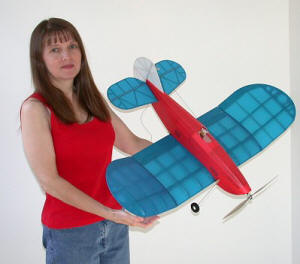
My
Li'l Poke uses a Great Planes ElectriFly 4CH FM receiver with
an ElectriFly C-10 electronics speed control (ESC), two Hobbico
CS-5 Nano servos (rudder and elevator), a Futaba S3106 servo
(aileron), and a Great Planes ElectriFly T-280GD Park Flyer
Motor System. For now, it will use an 8-cell NiMH, 650 mAh battery
pack. Final weight is 13.4 ounces (advertised is 12.5 - 14.5
oz).
See detailed photographs
below.
 Here
is a short clip of the 1st flight Here
is a short clip of the 1st flight |
On Sunday, February 19, 2006, I finally, after four months of
building, took it out for its maiden flight. After exercising
due diligence with range checking, battery tests, control checks,
etc., I confidently took off. The Li'l Poke tracked straight
as an arrow and lifted off beautifully. In the first turn I
noticed what seemed like a momentary loss of control, but figured
maybe the excitement of flying a new plane clouded my judgment.
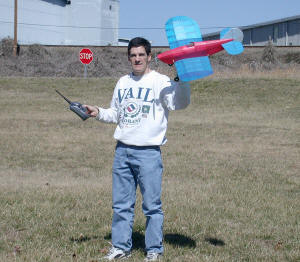 After
another turn, it happened again and I knew something was wrong.
At an altitude of about 100 feet, I turned to land and the plane
literally dropped out of the sky and headed straight down. By
some miracle, when it was about 15 feet off the ground, I regained
control and landed with a hard thud, and no visible damage.
After
another turn, it happened again and I knew something was wrong.
At an altitude of about 100 feet, I turned to land and the plane
literally dropped out of the sky and headed straight down. By
some miracle, when it was about 15 feet off the ground, I regained
control and landed with a hard thud, and no visible damage.
|
FCC Compliance
|
 Whenever
a device that emits radiation (intentionally or unintentionally)
is to be licensed, test results from an approved testing
facility must be submitted to prove Whenever
a device that emits radiation (intentionally or unintentionally)
is to be licensed, test results from an approved testing
facility must be submitted to prove
 compliance.
Along with the numerical results, internal and external
images are submitted. Clicking on the two image to the
right will open the FCC documents with full-size versions. compliance.
Along with the numerical results, internal and external
images are submitted. Clicking on the two image to the
right will open the FCC documents with full-size versions. |
Some post-flight testing revealed that the receiver exhibits
an almost total signal null at a couple different transmitter
(Futaba 6 ch) antenna positions. It does not matter whether
the Tx antenna is collapsed or fully extended. As a 30-year
RC flyer, I know how to properly install a radio system in an
airplane (and helicopters) and extend the antenna outside the
aircraft. I have never seen anything like this complete loss
of signal with certain transmitter antenna positions. What it
tells me is that the receiver is woefully inadequately designed
or it is the victim of very poor manufacturing quality. In the
future, I will stick with Futaba radio gear exclusively, since
in over 20 years of using it I have never had any kind of failure.
Stay tuned... One of the new
Spektrum DX6 spread spectrum RC systems (from
Horizon
Hobby) operating at 2.4 GHz has been ordered and will be
installed in the Li'l Poke. The system has a dual redundant
transmit/receive scheme with interference-free operation. Update:
the Spektrum DX6 radio was installed and has been working flawlessly
- absolutely no interference problems. I've has the Li'l Poke
up probably 500-600 feet to do spins, and have never had any
loss of control. This is a great system!!!
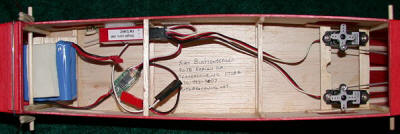
 Here
are a series of detail photos
that show radio and motor installation, as well as some shots
of the pushrod and control horn hookups. Covering was Coverite
Coverlite with Balsarite adhesive. The Coverlite covering is
unbelievably strong for its weight - it is even hard to tear
on purpose. The only aspect I do not like about using it is
having to paint on the Balsarite adhesive (the covering does
not come with adhesive applied). The inconvenience is
that every place the covering needs to overlap, you need to
paint a line of adhesive where the overlap will occur. Consequently,
you cannot the tops, bottoms and sides of areas in a single
session. Another really nice feature of the Coverlite is that
it stretches and shrinks extremely well with both an iron and
the heat gun. I was able to cover the compound curves of the
turtle deck and wingtips in single pieces (per side) without
any wrinkles - amazing!
Here
are a series of detail photos
that show radio and motor installation, as well as some shots
of the pushrod and control horn hookups. Covering was Coverite
Coverlite with Balsarite adhesive. The Coverlite covering is
unbelievably strong for its weight - it is even hard to tear
on purpose. The only aspect I do not like about using it is
having to paint on the Balsarite adhesive (the covering does
not come with adhesive applied). The inconvenience is
that every place the covering needs to overlap, you need to
paint a line of adhesive where the overlap will occur. Consequently,
you cannot the tops, bottoms and sides of areas in a single
session. Another really nice feature of the Coverlite is that
it stretches and shrinks extremely well with both an iron and
the heat gun. I was able to cover the compound curves of the
turtle deck and wingtips in single pieces (per side) without
any wrinkles - amazing!
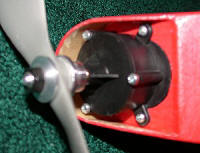
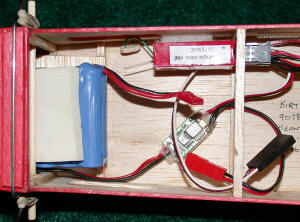
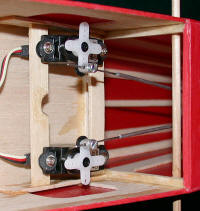
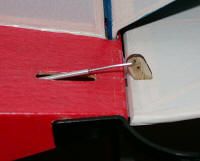
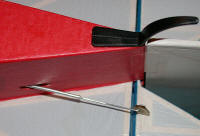
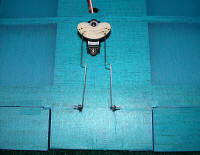
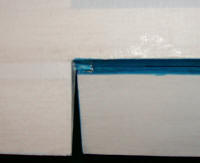
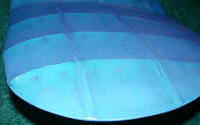
Note: The ailerons proved to be almost totally
ineffective, so I decided to remove the servo to save weight,
and glued the ailerons in place. They could be cut back out
and used again, but it really is not worth the trouble.
The first frame pictures are available now. Lightening holes
were drilled in all the wing ribs, and lightening holes were
cut in the fuselage. There just did not seem to be a good reason
to have that balsa sitting there just adding weight. I have
to say that Great Planes did not do a particularly good job
engineering this kit. Fuselage side lengths matched the plans
when flat, but ended up short when curved as they actually go
together. The polyhedral joints are implemented very stupidly.
Only the root rib for the outboard panel is slanted to accommodate
the dihedral, rather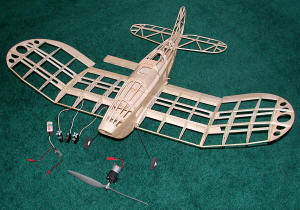 than dividing the slant between the center section end rib and
the outboard section root rib. What happens is that the root
rib for the outboard section is necessarily taller than the
others because its length is that of the hypotenuse of a right
triangle. That means when the two wing sections are butted together
for gluing, there is a about a 3/32" high step at the joint.
As I said - really stupid. It caused me to have to add a strip
of balsa in from TE (trailing edge) to LE (leading edge) to
smooth the transition. The other unforgivable blunder is that
the plans show the bottom TE balsa sheeting in
than dividing the slant between the center section end rib and
the outboard section root rib. What happens is that the root
rib for the outboard section is necessarily taller than the
others because its length is that of the hypotenuse of a right
triangle. That means when the two wing sections are butted together
for gluing, there is a about a 3/32" high step at the joint.
As I said - really stupid. It caused me to have to add a strip
of balsa in from TE (trailing edge) to LE (leading edge) to
smooth the transition. The other unforgivable blunder is that
the plans show the bottom TE balsa sheeting in
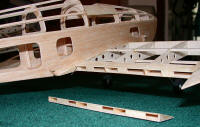 the
wrong location. It actually sits about 1/8" closer to the LE
than what is shown. Although not called for, I decided to add
some 1/32" stiffeners to the open areas between the ribs on
the wing TE and the front of the ailerons because leaving them
open creates an very weak and crush-prone edge. I can't imagine
why GP does not do that. Finally, I chose to use a DuBro miniature
tail skid instead of the one built out of 1/8" square balsa
per the plans. That balsa version, even when saturated with
CA, cannot last long. The entire frame has been coated with
CoverRite's BalsaRite, in preparation for covering with CoverLight.
the
wrong location. It actually sits about 1/8" closer to the LE
than what is shown. Although not called for, I decided to add
some 1/32" stiffeners to the open areas between the ribs on
the wing TE and the front of the ailerons because leaving them
open creates an very weak and crush-prone edge. I can't imagine
why GP does not do that. Finally, I chose to use a DuBro miniature
tail skid instead of the one built out of 1/8" square balsa
per the plans. That balsa version, even when saturated with
CA, cannot last long. The entire frame has been coated with
CoverRite's BalsaRite, in preparation for covering with CoverLight.
Earlier
Post: There is an interesting story to go with it already,
though. First, I'll say that of the many Great Planes kits I
have built in the last decade, all have had very good quality
balsa, bass and plywood. Their hardware I have never particularly
cared for. Anyway, the Lil' Poke is a backyard flyer and thus
should be constructed of lightweight balsa. Well, all three
1/16" rib sheets and the two 1/16" fuselage side sheets were
the hardest balsa I have ever seen anywhere. It was harder than
the stuff that used to come with the Guillows free flight rubber
kits. In fact, I weighed it on a postal scale an calculated
the density to be 18.3 lb/in³ - off the charts for balsa density!
Medium density balsa is 6 lbs/ft³. Tower Hobbies replaced the
sheets on request, so I'm satisfied. I offered to return the
original sheets to them, but they did not want them. The recommended
motor/gearbox and airborne flight pack were ordered to go with
it.
Here's a handy trick I just discovered: While cutting
and sanding the many balsa sticks that make up the Lil' Poke,
many times I end up sanding off just a tiny bit too much to
get that perfect fit. The old carpenter's joke that, "I've cut
the end of the board off three times now and it's still short,"
actually has a cure now for this application: Dip one or both
tips of the balsa stick in a drop of water to get just the right
amount of swelling. Pin the stick in place and let it dry, and
viola! Perfect fit!